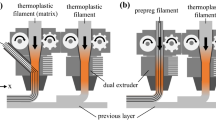Abstract
The manufacturing of lightweight shafts, pipes and profiles often uses hollow structures made from fiber reinforced plastics (FRP) due to their better density related properties. For applications with locally high tribological stresses, the use of FRP is not yielding proper results. In terms of lightweight construction, a hybrid design with a hollow FRP basic structure and local metallic elements in areas of high tribological stress is ideal for these applications. A promising approach for the production of these parts is rotational molding. Rotational molding for FRP–metal profiles is understood as a manufacturing process where machined, metallic elements and dry continuous fiber structures will be assembled and laid in a closed mold. Afterwards, the liquid matrix will be casted and the mold is then rotated at high speed until the fiber structure is fully impregnated and the matrix is cured. As there are short flow paths, this process is offering the potential to realize short cycle times of only a few minutes. Within this paper, the manufacturing of polygon profiles via rotational molding is described. These profiles can be produced by using centrifugal cores which were developed at the wbk Institute of Production Science. These cores are made of an elastomer composite material and they expand during the rotational molding process. The modeling of these cores and their impact on the impregnation pressure is shown here as well as their contribution in achieving higher fiber volume fractions.

















Similar content being viewed by others
References
Henning F, Moeller E (eds) (2011) Handbuch Leichtbau – Methoden, Werkstoffe, Fertigung, 1st edn. Carl Hanser Verlag, München
Collins JA, Busby H, Staab G (2009) Mechanical design of machine elements and machines, 2nd edn. Wiley, New York
Esmaeel RA, Taheri F (2011) Influence of adherend’s delamination on the response of single lap and socket tubular adhesively bonded joints subjected to torsion. Compos Struct 93:1765–1774
Lee SW, Lee DG (2007) Torque transmission capability of composite–metal interference fit joints. Compos Struct 78:584–595
Croccolo D, De Agostinis M, Vincenzi N (2012) Design of hybrid steel-composite interference fitted and adhesively bonded connections. Int J Adhes Adhes 37:19–25
Khalid YA et al (2007) Bending fatigue behavior of hybrid aluminum/composite drive shafts. Mater Des 28:329–334
Mutasher SA, Sahari BB, Hamouda AMS, Sapuan SM (2007) Static and dynamic characteristics of a hybrid aluminium/composite drive shaft. J Mater Des Appl 221:63–75
Fleischer J, Koch S, Gebhardt J, Schwennen J, Wagner H (2014) Intrinsische Hybridverbunde für Leichtbautragstrukturen, Fachtagung Thermoplastische Faserverbundkunststoffe, 5–6 Nov 2014, Erlangen, Deutschland, Thermoplastische Faserverbundkunststoffe, pp 199–207
Neitzel M, Mitschang P (2004) Handbuch Verbundwerkstoffe - Werkstoffe, Verarbeitung, Anwendung. Carl Hanser Verlag, Kaiserslautern, pp 329–333
Hufenbach WA, Helms O, Werner J (2007) Shaft to collar connections for high loaded composite lightweight gear components. Welle-Nabe-Verbindungen: Berechnung, Gestaltung, Anwendung, VDI-Berichte Nr. 2004
Hufenbach W et al (2005) Integrated pipe thread for the introduction of high loads into filament wound lightweight structures. In: VDI-Berichte (1903): Berechnung, Gestaltung, Anwendung, Schraubenverbindungen, pp 301–316
Darcy H (1856) Les fontaines publiques de la ville de Dijon. Dijon, Paris
Ehleben M, Schürmann H (2006) Manufacturing of centrifuged continuous fibre-reinforced precision pipes with thermoplastic matrix. Compos Sci Technol 66:2601–2609
Momentive Specialty Chemicals Inc. (2006) Technical Data Sheet—EPIKOTE™ Resin MGS® RIMR 135 and EPIKURE™ Curing Agent MGS® RIMH 134–RIMH 137. Issued: August 2006, Rev. 7/9/2014
Askeland DR, Fulay PP, Wright WJ (2011) The science and engineering of materials, 6th edn. Cengage Learning, Boston, pp 652–662
Wacker Chemie AG (2014) Technical data sheet for ELASTOSIL® M 4511—version 1.6
Lide DR (1999) CRC handbook of chemistry and physics, 80th edn. CRC Press, Boca Raton
ISO 37:2011 (2011) Rubber, vulcanized or thermoplastic—determination of tensile stress–strain properties
Mullins L (1969) Softening of rubber by deformation. Rubber Chem Technol 42(1):339–362
Voigt W (1889) Ueber die Beziehung zwischen den beiden Elasticitätsconstanten isotroper Körper. Ann Phys 274(12):573–587. doi:10.1002/andp.18892741206
Reuss A (1929) Berechnung der Fließgrenze von Mischkristallen auf Grund der Plastizitätsbedingung für Einkristalle. ZAMM Z Angew Math Mech 9(1):49–58. doi:10.1002/zamm.19290090104
Halpin JC, Kardos JL (1976) The Halpin–Tsai equations: a review. Polym Eng Sci 16(5):344–352
Gutowski TG (1985) A resin flow/fiber deformation model for composites. SAMPE Q 16(4):58–64
Otsu N (1979) A threshold selection method from gray-level histograms. IEEE Trans Syst Man Cyber 9(1):62–66. doi:10.1109/TSMC.1979.4310076
Acknowledgments
This paper is based on investigations of the collaborative research program “Schwerpunktprogramm 1712” which is kindly supported by the German Research Foundation (DFG—Deutsche Forschungsgemeinschaft).
Author information
Authors and Affiliations
Corresponding author
Rights and permissions
About this article
Cite this article
Fleischer, J., Koch, SF. & Coutandin, S. Manufacturing of polygon fiber reinforced plastic profiles by rotational molding and intrinsic hybridization. Prod. Eng. Res. Devel. 9, 317–328 (2015). https://doi.org/10.1007/s11740-015-0620-0
Received:
Accepted:
Published:
Issue Date:
DOI: https://doi.org/10.1007/s11740-015-0620-0




